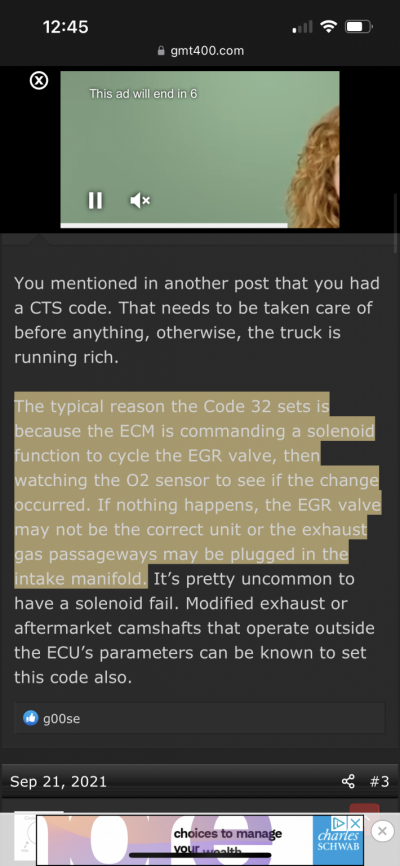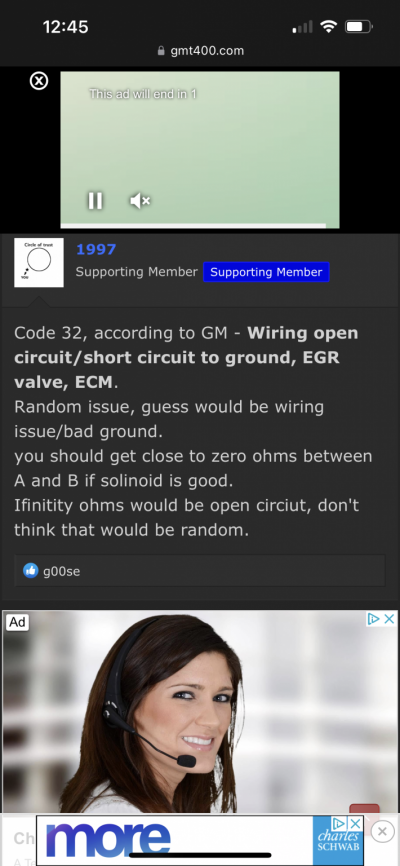Maui_chevyk1500
Newbie
Ok so my truck is A ‘94 Chevy k1500 5.7 auto pretty much stock.
I’ll start from the first time I got the code 32
Truck would drive fine on short trips for weeks but as soon as I would take it on any drive with highway speeds for a sustained amount of time, after it was parked it would not want to start again.
I Tried jumping it and checking all the obvious things but it seemed like no fuel or no spark.
Then I would return the next morning and it would start up first crank and run fine all the way home.
I soon read that the ecm takes a test reading after a certain amount of 50mph driving, It Cycles the EGR and waits to see if the difference occurs at 02 sensor. Based on that reading it can throw code 32.
From the beginning I have tried:
-new cap and rotor.
-Tested fuel pressure before the filter came out to around 10 psi.
-Fuel pump is only a few years old
-removed and cleaned EGR valve (it was definitely funky and black).
-replaced my temp sensor because I realized it was broken and unplugged.
- also check & replaced numerous grounds in the engine compartment.
-new spark plugs because it was needed
-checked vacuum system visually to verify correct and not damaged.
After spark plugs it actually seems to idle worse. Idle fluctuates slightly when it didn’t before
Also stalls from time to time at idle.
Basically still not sure if my problem lies with the EGR/MAP or a short to ground/ bad ground somewhere in the harness.
I am not very confident with a multimeter and I don’t want to keep throwing parts at it.
also it’s hard to tell at this point wether I’ve fixed it or not because I am hesitant to take it on a drive long enough to get possibly stranded.
I Would love to be able to positively identify the issue and know for sure it’s fixed.
Sorry for the long post but I hope it’s all helpful information.
Thanks in advance for any input!
I’ll start from the first time I got the code 32
Truck would drive fine on short trips for weeks but as soon as I would take it on any drive with highway speeds for a sustained amount of time, after it was parked it would not want to start again.
I Tried jumping it and checking all the obvious things but it seemed like no fuel or no spark.
Then I would return the next morning and it would start up first crank and run fine all the way home.
I soon read that the ecm takes a test reading after a certain amount of 50mph driving, It Cycles the EGR and waits to see if the difference occurs at 02 sensor. Based on that reading it can throw code 32.
From the beginning I have tried:
-new cap and rotor.
-Tested fuel pressure before the filter came out to around 10 psi.
-Fuel pump is only a few years old
-removed and cleaned EGR valve (it was definitely funky and black).
-replaced my temp sensor because I realized it was broken and unplugged.
- also check & replaced numerous grounds in the engine compartment.
-new spark plugs because it was needed
-checked vacuum system visually to verify correct and not damaged.
After spark plugs it actually seems to idle worse. Idle fluctuates slightly when it didn’t before
Also stalls from time to time at idle.
Basically still not sure if my problem lies with the EGR/MAP or a short to ground/ bad ground somewhere in the harness.
I am not very confident with a multimeter and I don’t want to keep throwing parts at it.
also it’s hard to tell at this point wether I’ve fixed it or not because I am hesitant to take it on a drive long enough to get possibly stranded.
I Would love to be able to positively identify the issue and know for sure it’s fixed.
Sorry for the long post but I hope it’s all helpful information.
Thanks in advance for any input!



